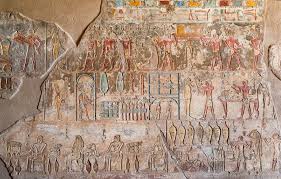Tomb of Renni
Renni held the position of Nomarch of El Kab and Overseer of the Priests of Nekhbet during the reign of Amenhotep I, at the beginning of the Eighteenth Dynasty. The Tomb of Renni (also known as Reni, Rini, and Reny) dates back to the Eighteenth Dynasty and more precisely from the reign of Amenhotep I (1525-1504), whose Djseser-ka-Ra "cartouche" is legible in the arch above the niche, at the back of the tomb. The ritual scenes in his tomb represent the ceremony of the opening of the mouth and the worship of Osiris and Anubis cheek by jowl with other depictions of offerings presented by the members of his family. Agricultural scenes decorate different sides of the tomb. Farmers are shown involved in farming under the supervision of Renni. A banqueting scene can also be found, where the deceased and his wife are represented in front of their guests.





